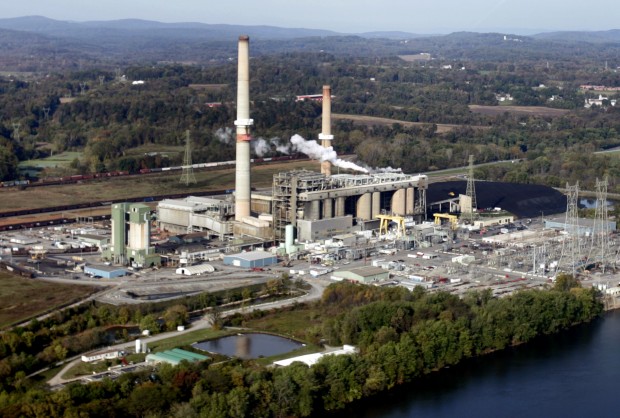RGGI states, boosted by Trump’s Paris withdrawal, to make deeper carbon cuts
-
Jon Hurdle

Carolyn Kaster / The Associated Press
PPL’s Brunner Island coal-fired plant located on the west bank of Susquehanna River. The Regional Greenhouse Gas Initiative agreed to further cuts in carbon emissions. Although Wolf pledged to join RGGI during his election campaign, Pennsylvania is still not a member of the compact.
Nine northeastern states that make up the Regional Greenhouse Gas Initiative said Wednesday they plan to increase the rate at which carbon emissions are cut at their power plants, proposing a cut of 30 percent between 2021 and 2030.
The new cuts represent a reduction of 132 million more short tons of carbon than previously planned. That’s the equivalent of taking 25 million cars off the road for a year, and would mean that the RGGI members have cut power-sector emissions by 65 percent from 2009, when the initiative started.
The new cap will require an annual emissions cut of 2.275 million tons from 2021 to 2030, compared with 2.16 million tons this year. Between 2014 and 2020, RGGI emissions are due to decline by 14 percent, or less than half of the rate of the new target.
The plan continues actions by U.S. cities, states and businesses to pursue carbon cuts despite the Trump administration’s withdrawal in June from the Paris climate accord to limit a global rise in temperatures by cutting emissions.
“Today’s announcement by nine RGGI states that together represent the world’s sixth-largest economy is another powerful rebuke to the Trump administration’s dangerous denial of climate change and a strong signal to the rest of the world,” said Bruce Ho and Jackson Morris, analysts at the environmental group Natural Resources Defense Council, in a blog post.
The RGGI states began the previously scheduled program review in November 2015, about a year before Trump became President, but the new proposal shows the importance of state action in the absence of federal leadership, the NRDC said.
“With the Trump administration’s reckless climate denial, the time for state and regional climate leadership has never been more important,” it said. “Statements from some of the RGGI states make clear that they are acting in the face of federal inaction.”
Power-plant emissions, the biggest single category of carbon pollution, would have been sharply cut under the Clean Power Plan, an Obama-era regulation that has been challenged in the courts and shelved by the Trump administration.
The proposal follows California’s recent adoption of legislation to extend its carbon market. Two members of RGGI, New York and Massachusetts had pushed for even greater cuts.
Neither Pennsylvania nor New Jersey belong to RGGI but both New Jersey gubernatorial candidates, Democrat Phil Murphy and Republican Kim Guadagno, pledged to rejoin. Pennsylvania Gov. Tom Wolf made it a campaign promise to join the initiative if elected, but Wolf’s spokesman, J.J. Abbott, said Wednesday that possible RGGI membership is not currently under discussion.
“Governor Wolf is open to conversation with the General Assembly and stakeholders about ways to continue to reduce emissions from Pennsylvania’s energy sector, but is not actively evaluating this option at this time,” Abbott said in a statement.
Delaware, however, is a member, and its Democratic governor, John Carney, issued a statement welcoming the new emissions cap.
“In the absence of federal leadership on climate change, RGGI is a critically important tool for ensuring real reductions in planet-warming greenhouse gases such as carbon dioxide,” Carney said. He said the new target will also help meet the goals of the U.S. Climate Alliance, a group of 14 states that has committed to meeting the goals of the Paris climate accord.
Participating states sell emissions allowances to power generators which are incentivized to reduce their emissions – by switching to cleaner burning fuels or using more renewables – because it will mean they have to buy fewer allowances. The states use the revenue to support initiatives like switching to solar power or energy-efficiency programs.
The states sell a decreasing number of allowances at quarterly auctions. Power plants purchase the allowances or trade them in the market to allow for their emissions.
“What this cap does is it puts a finite number on how much pollution can come out of those smoke stacks in those states,” said NRDC’s Morris. “And then you reduce the amount of those allowances year over year. Thereby guaranteeing reductions over time from all these nine states.”
The program has cut carbon pollution from power plants by 40 percent since 2009, has reduced consumers’ energy bills by more than $600 million because of greater investment in renewables and energy efficiency, and has improved public health by improving air quality, the NRDC said.
The RGGI states plan to present further details on the plan and take public comments at a public meeting in Baltimore on Sept. 25. Those states include Connecticut, Maine, Massachusetts, New Hampshire, Rhode Island, Vermont, New York, Delaware, and Maryland.
Susan Phillips contributed to this report.
This story has been updated with comments from Gov. Wolf’s spokesman.
















